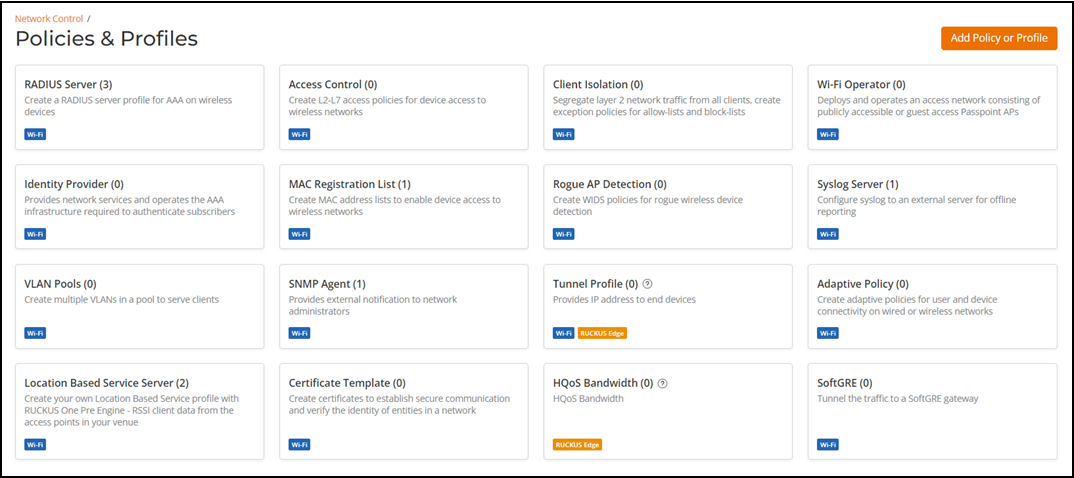Service Catalog
The Service Catalog is a collection of configurable network services that help manage connectivity, authentication, security, and traffic control in RUCKUS One. Each service can be added and configured to define how your network authenticates users, authorizes access, monitors performance, and secures communication.
The following network processes can be
automated using the Service Catalog:
- Authenticate users and devices.
- Authorize user and device access.
- Maintain user and device activity records.
- Manage network traffic from connected devices.
- Identify user violations and unauthorized connected devices.
The following are the benefits of
using the Service Catalog:
- Network and device configurations can be automated.
- You can monitor network performance and traffic.
- Network violations are detected more efficiently.
- Threats are detected and contained more quickly.
- Identify the users and devices that pose a security risk.

The Service Catalog includes a variety of services that you can configure to meet your network requirements:
| Access Control | Create L2–L7 access policies for device access to wireless or switch networks. | |
| Adaptive Policy | Create adaptive policies that govern user and device connectivity on wired and wireless networks. | |
| AV Profile | Apply predefined or custom audio-visual configuration templates to ICX switch ports for optimized AV performance. | |
| Certificate Management | Create and manage certificates to establish secure communication and verify network identities. | |
| Client Isolation | Segregate Layer 2 traffic between clients and create allow-lists and block-lists to permit or restrict communication. | |
| DHCP | Provide client DHCP address assignments from Access Points or RUCKUS Edge. | |
| Directory Server | Create Active Directory or LDAP server profiles for authentication on captive portal networks. | |
| DPSK | Enable RUCKUS Dynamic Pre-Shared Key (DPSK) service for secure, per-device network access. | |
| Identity Provider | Create Identity Provider (IdP) profiles for Hotspot 2.0 and Captive Portal SAML authentication services. | |
| IPsec | Secure IP communications using encryption and authentication through IPsec profiles. | |
| Location Based Service Server | Create Location Based Service (LBS) profiles to deliver RSSI client data from venue access points to external LBS engines. | |
| MAC Registration List | Create lists of MAC addresses to authorize specific devices for wireless network access. | |
| mDNS Proxy | Proxy multicast DNS requests to enable discovery of Layer 2 services across VLANs. | |
| Port Authentication | Define 802.1X and MAC authentication profiles for wired switch clients and apply them at the port level. | |
| Port Profiles |
Create profiles that define how switch ports behave and function.
|
|
| Portal | Create a web authentication portal for guest network access or PIN-based login services. | |
| RADIUS Server | Create a RADIUS server profile for AAA authentication on wireless networks. | |
| Wi-Fi Operator | Provide Hotspot 2.0 operator configurations to support guest access and public Wi-Fi services. | |
| Resident Portal | Create a portal for resident authentication and property management integrations. | |
| Rogue AP Detection | Create WIDS policies to detect and report rogue wireless devices. | |
| SD-LAN | Simplify network management through centralized control, automation, and programmability for local networks. | |
| SNMP Agent | Configure SNMP trap destinations for sending alerts and notifications to external monitoring systems. | |
| SoftGRE | Create SoftGRE tunnel profiles to forward client traffic from APs to a SoftGRE gateway. | |
| Syslog Server | Configure Syslog servers to receive log messages and system events from network devices. | |
| Tunnel Profile | Provide IP address assignments to end devices through configured tunnel profiles. | |
| VLAN Pools | Create a pool of VLANs to dynamically assign VLANs to clients for distribution and scalability. | |
| Wi-Fi Calling | Identify Wi-Fi calling clients and apply enhanced Quality of Service (QoS) settings. | |
| Wi-Fi Operator | Deploy and operate Passpoint access networks for publicly accessible or guest Wi-Fi services. | |
| Workflows | Create workflows to automate network configuration tasks and operational activities. | |